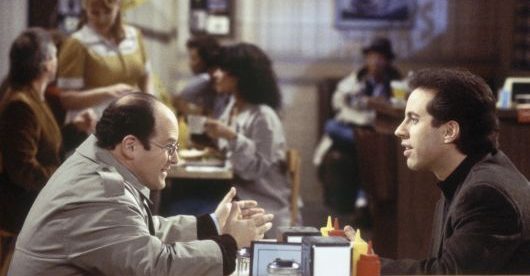How the Past on TV Moves Faster, but Only So Slightly

Between Netflix, HBO, Amazon Prime, Hulu, and a cadre of other paid TV streaming services, one can only imagine how traditional, advertising-supported television is faring. Our increasing on-demand world hasn’t been kind to the universe of ad-supported content out there, and television is no exception. In fighting against these currents, TV execs have looked for revenue hiding in all sorts of places. And one obvious one is to simply run more ads.
The rule of thumb in TV — at least now — is that a 30-minute TV show should have a run-time of no longer than 22 minutes, with the other eight minutes reserved for ads and a little bit of lost time here and there. That’s a hard cap, designed to make room for an increasing amount of ad space. In 2009, networks ran about 14.5 minutes of advertisements per hour, according to a 2017 study conducted by ratings giant Nielsen (via Lifehacker). But in recent years, they’ve been trying, aggressively, to get the amount of content down to allow for more commercials. And they’ve been successful; per that same Nielsen study, today, you’ll get about 15.8 minutes of commercials in your hour of TV programming.
For new productions, that’s not a problem — the networks can demand that studios deliver about 21 minutes of content per episode. But when it comes to reruns, the networks are stuck with whatever was the standard of the day — and those standards often allowed for longer programming. Episodes of Friends ranged from 20 to 22 minutes, pushing the envelope by today’s monetization needs. Episodes of Frasier often extended to 23 minutes, which won’t work at all. The Golden Girls and Seinfeld ranged from 22 to 24 minutes long, which is similarly a non-starter. And many other shows from the 80s and 90s had similar episode lengths.
The run-time aside, older shows offer a cost-saving opportunity to the TV networks — reruns are cheaper than new content, and in the examples above, the old episodes still draw viewers. But because of the longer run-times, networks couldn’t run the full block of 15.8 minutes each hour — at least not without making changes to these popular reruns. Some of those changes are pretty boring, like cutting the opening theme song down as much as possible. But one, while simple, is really creative: they fast forward the TV show. Just very slightly.
As CBS explains, many networks are speeding up the shows they’re airing. TBS, for example, broadcast episodes of Seinfeld at a speed about 7.5% faster than the episodes were originally broadcast on NBC. A 23-minute episode, therefore, would take up only 21.4 minutes, giving TBS an additional 1.6 minutes of ad time per half hour. That’s enough for five or six extra 15-second slots. For the TV network, that’s a lot more revenue.
As for the viewer? It’s not clear if we notice such a minor change. Sure, the voices are little higher pitched, the comedic pauses are a tad less of a pause, and some characters may come off as more frenetic than before — but that probably hits us on a subconscious level, if at all. But don’t take my word for it — you can judge for yourself. Slate put together a quiz featuring nine segments from popular TV shows, some of which are sped up by 8%. You can take the quiz here to see if you can tell whether one of your favorite shows is being broadcast with the fast-forward button lightly pressed. (For what it’s worth, the average Slate quiz-taker scored six out of nine.)
Bonus fact: Seinfeld lasted nine seasons and made billions of dollars — but it could have kept going. Despite the fact that Jerry Seinfeld was being paid $1 million per episodes (and his castmates were getting $600,000 each, per the New York Times), NBC wanted to continue with a tenth season. And they were willing to pay even more. Per Vulture, “[Jerry] was offered $5 million per episode, or $110 million per year,” but declined anyway. Maybe it’s because he just didn’t need the money? According to CNBC, “as one of the show’s creators, he gets a cut of the show’s lucrative and ongoing syndication deals, which are estimated to have brought in over $3 billion since 1995. Seinfeld’s cut comes to about a whopping $400 million over that time period. ”
From the Archives: A Festivus for the Peruvians: Festivus is a made-up holiday created by the Seinfeld writers. But in one tiny section of Peru, it’s kind of real. Kind of.
